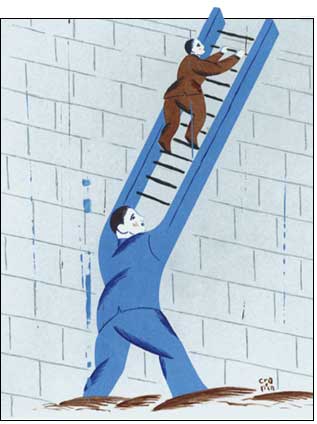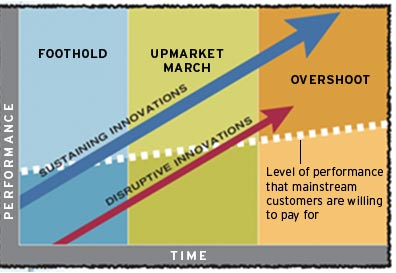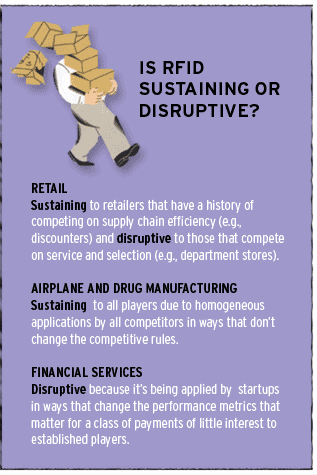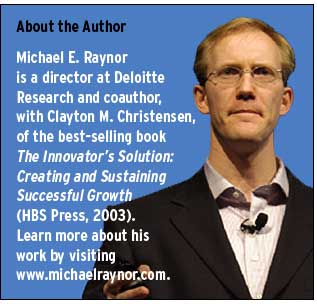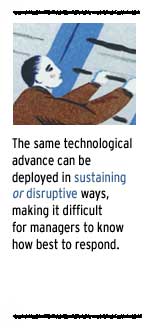Many companies looking to meet mandates from Metro, Target, Tesco, Wal-Mart and other major retailers are discovering that integrating RFID into supply chain management is no easy task. It requires product innovation from vendors of tags and readers, and significant process innovation from users if they are to see any benefit from their newfound abilities to collect and analyze data. And there needs to be a positive feedback loop between product and process innovations, with each step forward by either half of the equation spurring the other half to improve still more.
Determining how best to manage the product and process innovations that RFID makes possible, and in some cases demands, requires a solid theory of innovation. “Theory” for many managers is a dreaded word. But a good theory can explain causal relationships, which helps managers to not only predict but control the outcomes that interest them.
|
|
What emerges from a theory-based analysis of RFID is that for some companies, no matter how tumultuous the changes required to incorporate RFID into their business, there’s little to be concerned about: Established processes for incorporating innovation will do just fine. For others, however, RFID represents the kind of secular change that could reorder the industry leaders, depriving powerful incumbents of much-needed growth and perhaps even undermining their business altogether. Worse still, who needs to worry and who doesn’t is likely to be the inverse of what many analysts and commentators have suggested.
The reason for this topsy-turvy world is that RFID is “merely” a technological breakthrough. Innovations of any type realize their true value only when embedded in specific business models. And it turns out that RFID has many different applications. Some simply make it possible to do better the very things companies have been trying to do all along. But some promise change of an entirely different sort. Understanding the differences, and what to do about them, is critical to the success of both users and vendors of RFID technology.
Disruption theory has proved a powerful way to understand the effects of an innovation on a market. The theory is based on a distinction between sustaining and disruptive innovations, each of which has very different characteristics that, in turn, have profound implications on how best to implement and commercialize that innovation. The process of disruption is summarized in the chart below.
In every market there is a rate of improvement that a company’s customers can utilize or absorb, represented by the dotted line sloping gently upward across the chart. There is, of course, a distribution of customers around this central tendency. Customers in the most demanding tiers may never be satisfied by the best products or services available, and those in the least demanding tiers may find that comparatively low levels of performance are more than they need.
There’s a distinctly different trajectory of improvement that innovating companies provide as they introduce new and improved products. This pace of technological progress almost always outstrips the willingness of customers in any given tier of the market to pay for it, as the more steeply sloping solid lines in the chart suggest.
The reason is that companies must win over new, and typically more demanding, customers to grow faster than the growth in consumption of their existing customers. And so companies work hard to improve their products faster than their existing customers can absorb those improvements in order to catch up with the needs of the more demanding tiers of the market.
Sustaining innovations are what enable organizations to appeal to increasingly more demanding customer segments, and hence grow. Sustaining innovations can be incremental, year-by-year improvements, or breakthrough, leapfrog-beyond-the-competition offerings. Either way, as companies move along their sustaining trajectories, they inevitably overshoot at least some, if not much, of the market, effectively leaving behind those segments of the market whose needs can be satisfied with products that are not as good as what the most successful organizations are capable of providing.
Overshooting the market
It is this overshoot that makes disruption possible. Disruptive innovations are inferior to the currently available products, as measured by traditional performance metrics, but they offer other benefits. Typically, disruptive innovations are simpler, more convenient and often less expensive, too.
Such products appeal to new or less demanding customer segments, and these segments present the disruptive innovation with a foothold in the market. Once a foothold is established, the new innovation has a market that will pay for further improvements in its performance, and so a new trajectory of sustaining improvement is created. As the innovation improves, it begins to attract customers in other, more demanding market segments, and the upmarket march has begun. Once the level of performance demanded by mainstream customers has been reached, the disruption is essentially complete. The market’s incumbents might well survive, even profitably, but they are invariably smaller and have limited growth options.
The airline industry offers a good example of disruptive innovation. From the inception of commercial air travel in the post–World War II era through the late 1980s, established airlines introduced a stream of innovations that allowed them to provide ever-better service to their most attractive customers: the relatively price-insensitive business travelers who wanted predictable levels of service to as many destinations as possible.
Sophisticated reservation systems, frequent-flier programs, hub-and-spoke route structures and various classes of service were all crucial to success. And since all the airlines had the same generic strategy, execution was the name of the game: do it better and faster than the competition, because the competition was sure to copy you.
For the first two decades after its launch in 1971, Southwest Airlines labored in relative anonymity. The company was profitable but small, and prospered by bringing low-cost air travel to people for whom the alternative wasn’t another air carrier, but a bus or car.
In the 1990s, Southwest began to eat into the established carriers’ markets, and by May 2003, Southwest had more passengers than any other U.S. airline. What happened? How could a company offering infrequent flights from secondary airports with poor service best the stalwarts of the industry?
Southwest was successful because it disrupted its entrenched competitors. As established air carriers, such as Delta, United and American, fought for higher margins by catering to price-insensitive business travelers, they effectively left behind an increasingly large number of customers.
As the incumbents were on the path to “overshooting” the needs of more of the market, Southwest was busy catching up with the needs of those same customers. The carrier improved significantly in many operational dimensions, but it did not compromise the essence of its strategy. The combination of Southwest’s improvements and the incumbents’ overshoot allowed Southwest to ascend to the summit of its industry. An important learning from the Southwest case is that disruptive innovations are not limited to, or even typically about, technology.
The relativity of disruption
Disruptive innovations are so-called because of the effect a given technological advance has on the business model around which it’s wrapped. Consequently, the same technological innovation can be deployed in sustaining or disruptive ways. It’s the contingent nature of the disruptive or sustaining potential of any given technology that makes it difficult for managers to know how best to respond to a given innovation.
The Internet was particularly prone to being mismanaged because of this kind of confusion. In the mid- to late 1990s, it was common for the Internet to be hailed as an engine of bona fide disruptive innovation in just about every sector of the economy. As it turned out, the Internet had applications that were sustaining to some companies, yet distressingly disruptive to others—sometimes within the same industry.
Consider the experiences of Dell Computer and Compaq (since acquired by Hewlett-Packard) in the personal computer market. Compaq (itself once a disruptor of IBM) sold through third-party distribution channels. Its distributors were a critical part of its business model, because the market segment that Compaq valued most consisted of demanding corporate accounts that required frequent and extensive service.
In contrast, Dell developed a direct model that initially relied on the telephone. As a consequence, Dell had to settle for the less demanding consumer segment, which was willing to put up with less service in exchange for far lower prices on less powerful machines.
The consumer segment was Dell’s foothold. The company was able to improve the quality of support and service it offered without sacrificing the cost advantages of its direct model. And one of the technological innovations that allowed Dell to make these improvements was the Internet. By dealing with customers through the Web, Dell was able to do still better all of the things it had previously been trying to do for all of the customer segments that it had been serving or trying to serve better. Therefore, the Internet was sustaining to Dell’s business model.
For Compaq, however, the Internet was yet another disruption to its established business model. Compaq was still caught between the Scylla of its distributors and the Charybdis of Dell’s low-cost—yet increasingly service-capable—model.
In many ways, RFID bears some striking similarities to the Internet. Just as the Internet was a 30-year overnight success story, RFID has been around for decades, yet only recently has begun to dominate the headlines. And just like the Internet, RFID has sustaining and disruptive applications.
RFID’s supply chain applications have gotten the most attention, largely because of Wal-Mart’s highly visible endorsement of a widespread deployment of the technology in its own business. But this application is fundamentally sustaining to Wal-Mart’s business, which has long been based on a superior supply chain management system grounded in the practical application of leading-edge technology. The company was among the first to exploit the benefits of large-scale cross-docking proprietary satellite-based communications networks.
For Wal-Mart, as for other retailers who compete based on their supply chain efficiencies, RFID is simply another turn of the crank. The changes required to adopt RFID might be wrenching at times, but they pose no fundamental challenges to the organization’s underlying business model.
Similarly, just as the Internet was sustaining to Dell but disruptive to Compaq, RFID promises to exacerbate the disruptive pressures that Wal-Mart and other successful discounters, such as Target and Old Navy, are putting on full-service department stores.
Other sectors are characterized by a remarkable homogeneity of application. In aircraft manufacture, for example, both Boeing and Airbus have agreed on a standard for tracking parts and seem to be deploying the technology in fundamentally similar ways. As a result, neither player can use RFID to build a competitive advantage based on sustaining or disruptive innovation. In pharmaceuticals, all the major players seem to be limiting their deployment of RFID, for now at least, to a common implementation of FDA recommendations to track and trace drug shipments to reduce counterfeiting. Again, there will be no advantage found here, because advantage lies in differences, not similarities.
Financial services is a sector where RFID could have potentially disruptive applications beyond the supply chain. In the payment space, for instance, credit and debit cards dominate the industry. Conventional wisdom holds that credit cards are used for large purchases and debit cards for small ones.
But what about payments of under $20, which are still mostly made in cash? If the credit card and debit card companies were to go after these transactions, such transactions would cost the companies just as much to process as the larger payments do. Yet these transactions would generate small commissions for the credit and debit card providers, so these providers are not nearly as strongly motivated to convince customers to use their credit or debit cards for these payments. Instead, they tend to devote their energies to gaining a greater share of larger payments.
In contrast, Dexit, a Canadian payment service provider, has been rolling out a payment service based on RFID. In classic disruptive fashion, it’s targeting a slice of the market that means little to established and powerful providers of credit and debit card services—namely, small cash payments.
If it’s successful, the credit and debit card companies won’t even see Dexit’s growth because the company is taking transactions that the credit card companies never had in the first place. But if Dexit is able to execute an upmarket march, eventually it may disrupt established providers. (The sustaining or disruptive natures of these applications of RFID are summarized in the table.)
Insights for RFID vendors
Companies that use RFID technology need to understand whether they are seeking to effect sustaining or disruptive innovation, since each makes very different demands on an organization (more on this below). But the lessons of disruption theory speak to vendors of RFID technology as well.
Because the technology has a long history, there are already well-established and highly capable providers of RFID tags and readers with specific performance profiles. Incumbents such as Philips and Texas Instruments have built strong businesses that succeeded by delivering the performance characteristics their customers demanded.
Because early RFID technology was expensive, it was deployed by companies with high-value products. For example, railroad companies tracked rolling stock worth tens of thousands of dollars. Similarly, European trucking companies that had to contend with the double whammy of smaller roads (which meant smaller trucks and hence more trucks for a given volume of shipping) and higher gasoline prices were willing to spend far more than U.S. trucking companies to avoid misdirected or lost shipments.
In working to solve these customers’ problems, incumbents focused on high levels of functionality, with cost a secondary consideration. If the readers cost $50,000 and the tags were $5 each, that was OK, because the cost model fell within the needs of the only customers for the technology.
As discount retailers look to deploy RFID as a sustaining innovation in their supply chains, they will need RFID technology with a very different cost/performance trade-off. They don’t need 384 bits of memory and read-write capability—if that comes at a price of $1 per tag or more. They need 5-cent tags and will settle for little more than a product code.
Incumbent providers of RFID technology are, like all well-run companies, hostage to their existing customers. Established airlines have found it all but impossible to mimic Southwest’s business model, even as Southwest has begun to steal some of their more valuable customers. Similarly, established RFID vendors will find it difficult to shift their resources away from the sustaining innovations demanded by their existing customers in order to develop the low-cost solutions that new adopters are looking for.
As a result, among the plethora of new entrants into the RFID vendor space, companies with the best chance of success are those that exploit the asymmetry of motivation between them and their established competitors. By seeking customers with needs very different from those of the customers currently served by incumbents, new entrants have a chance to find a foothold market that, ultimately, holds out the promise of disrupting the entire industry.
The reason that understanding the distinction between sustaining and disruptive innovation is so important is because the best way to manage each is very different.
Sustaining innovations are, by definition, consistent with the established business model of the organization. As a result, in any successful firm, established processes for evaluating and implementing sustaining innovations are entirely up to the task.
For example, it’s unlikely that Wal-Mart needed to do anything special when it came to evaluating the potential of RFID. The firm has a long history of making the right choices no matter how radical the technologies or how material the changes to processes, systems, structures or procedures.
On the other hand, disruptive innovations demand a radically different approach, primarily because they require organizations to do what they (the good ones, at least) are genetically programmed not to do: ignore their best customers. In practice, this requires that established firms seeking to exploit technology in a disruptive way have to set up independent business units that can focus on the foothold market and find a viable beginning for the upmarket march.
As it turns out, Dexit, the Canadian payments provider, is owned in part by TD Canada Trust, one of the country’s largest banks and an issuer of credit and debit cards. This suggests strongly that TD sees the disruptive potential in RFID-enabled payments and has created the organizational space required to see this potential to fruition.
For new entrants in the RFID vendor space, the key will be to focus on the customers incumbents don’t want and the technologies they scorn. Startups that bank on having “better technology” might make money for their investors, but only if they find a way to sell out in a timely fashion. History is littered with the corpses of startups founded on the basis of having a better mousetrap—only to be crushed by established companies that, once roused, proved indomitable foes.
For incumbents, the critical element, as TD Canada Trust seems to have realized, is to create autonomous business units focused not so much on different technology as on different customers. And not just any old different customers: worse customers that demand worse products and services.
It’s all about the customers . . .
Business success must be based on meeting customers’ needs. Disruption theory is a different way of thinking about innovation and competitive success, but it doesn’t violate any laws of economics: Only firms that have paying customers can survive and thrive.
But what disruption theory emphasizes is the ways in which different customers set organizations on different trajectories of product and service improvement. Inevitably, the firms that do successfully address the needs of a given customer segment are the ones that see their future lying in serving those customers ever better.
This isn’t a bad thing: Successfully appealing to the increasing needs of a given customer group lies at the heart of profitable growth in any company. But unfortunately, every such trajectory of improvement eventually runs out of headroom. Consequently, persistent, profitable growth requires finding a new trajectory of improvement.
Finding these new pathways to growth is what disruptive innovation is all about. And the source of new growth trajectories almost always lies with new customer groups. The fact that so few organizations grow profitably over any meaningful period of time seems to show that deliberately and repeatedly finding disruptive growth trajectories is enormously difficult. But repeated, purposeful disruption has been rare in the past perhaps in large part because a comprehensive theory of disruption—what it is, how to identify it and how to implement it—has been missing. The hope is that recent advances in disruption theory will make it possible for some organization—perhaps yours—to achieve what so few companies have.

